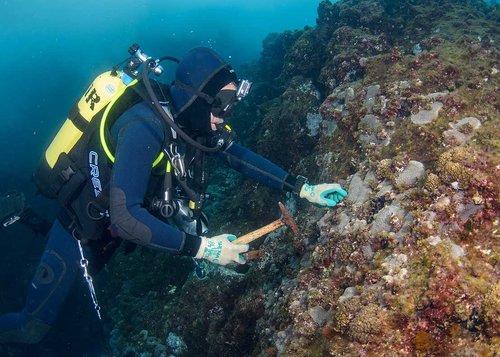
Fragments of coral collected by Massey University scientists have inspired a Christchurch artist to create an exhibition of paintings, with the exhibition opening this weekend.
Christchurch-based artist, Viv Kepes, visited Massey laboratories in Auckland last year, taking hundreds of photos of small coral fragments collected from Rangitahua (the Kermadec Islands), which lie 1000 km northeast of the North Island of New Zealand. She then used these photographs as inspiration for a suite of painted works.
Kepes was captivated by the perfection of the delicate, repeating, and gradually changing organic forms in the coral’s skeletal structures. She was drawn to share their presence and beauty to a wider audience through her artwork. She also wanted to support the important role of the pristine Rangitahua marine sanctuary, and the research being conducted there to protect these modest creatures.
The coral was collected by Massey’s Dr David Aguirre and Dr Libby Liggins, during expeditions in 2015, 2016, and 2017 when they gathered samples from several species of coral found around Rangitahua. The coral fragments no longer have their colourful soft tissue but have been prepared so that the skeletal structures can be observed. The same organic forms in which the artist found beauty have been intricately measured by the scientists to help understand the corals.

Dr David Aguirre prepares to take a small coral sample at Dougal rock, Raoul Island [Credit: Crispin Middleton].
Research meets art
Dr Aguirre says they collected the coral to better understand the unique adaptations that allow corals to survive in this isolated, rugged place.
“Coral reefs around the world are under the immediate threat of global climate change, and in particular, a phenomenon known as ‘coral bleaching’,” Dr Aguirre says. “Increases in ocean temperatures trigger a cascade of physiological reactions within the tissue of the coral that causes corals to lose their resplendent coloration, and instead adopt a sickly bleached appearance resulting in starvation.”
“Coral bleaching has never been studied in Rangitahua. Ultimately we want to calibrate their potential to endure the global climatic changes predicted in the future.”
Kepes will be showing the paintings, created as part of her Masters’ in Fine Arts at Canterbury University, at her upcoming exhibition Remember Me. Rangitahua’s Treasure in Christchurch in February, with Dr Aguirre and Dr Liggins attending the opening. She will also publish a book to support the painted works. She has also been supported by Ngati Kuri, Mana Wheuna of Rangitahua (Kermadecs).
The show opens at PG Gallery (192 Bealey Ave, Christchurch) on Feb 18 at 5.30pm and will run for a month.